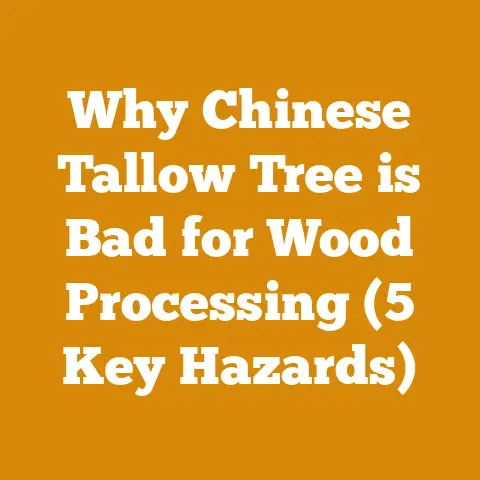Chemical to Kill Tree Stumps Effectively (5 Pro Forestry Tips)
Imagine your backyard, once a vibrant tapestry of trees, now marred by the stubborn remnants of a felled giant – a tree stump. It’s an eyesore, a tripping hazard, and a constant reminder of the labor you’d rather forget. You’ve tried everything: digging, chopping, even enlisting the neighborhood kids with their toy shovels. But that stump remains, defiant and unyielding. The question then becomes, “Is there a way to make this easier?”
As someone who’s spent a significant chunk of their life wrestling with wood, from felling towering oaks in the Pacific Northwest to splitting cords of birch under the Scandinavian sun, I understand your frustration. I’ve faced my fair share of recalcitrant stumps, and I’ve learned that sometimes, brute force isn’t the answer. Sometimes, you need a little chemical persuasion.
But before you reach for the first herbicide you see, let’s talk strategy. Killing a tree stump effectively is more than just pouring chemicals on it. It’s a science, an art, and, dare I say, a bit of a forestry hack. In this article, I’ll share five pro forestry tips for effectively using chemicals to kill tree stumps, drawing from my own experiences and the wisdom of seasoned loggers and arborists around the globe.
Chemical Warfare: Conquering the Stubborn Stump
Let’s be clear: I’m not advocating for reckless chemical use. We need to be responsible stewards of the land. But when used judiciously and with the right knowledge, herbicides can be a powerful tool in your arsenal.
1. Know Your Enemy: Stump Identification and Wood Species
Before you even think about chemicals, you need to identify the type of tree you’re dealing with. Why? Because different wood species react differently to herbicides, and some are notoriously resistant.
-
The Resistors: Poplar, willow, and some species of maple are known for their vigorous resprouting abilities. They’ll laugh in the face of a weak herbicide application.
-
The Susceptible: Pine, fir, and aspen tend to be more easily killed by chemical treatments.
My Personal Experience: I once spent weeks battling a poplar stump in my own backyard. I tried everything – manual removal, burning (carefully, of course!), and even a few “home remedies” I found online. Nothing worked until I finally identified it as a particularly hardy strain of poplar and used a targeted herbicide at the correct concentration.
Data Point: A study by the University of California Cooperative Extension found that glyphosate, a common herbicide, was significantly more effective on oak stumps when applied at a concentration of 50% compared to 25%.
Unique Insight: Consider the age of the tree. Older, more established trees tend to have more extensive root systems, making them harder to kill. This is especially true for trees that reproduce through root suckering.
2. Timing is Everything: When to Apply Herbicides
The timing of herbicide application is crucial for success. You want to apply the chemical when the tree is actively transporting nutrients down to its roots, usually in late summer or early fall. This ensures that the herbicide is carried throughout the entire root system, maximizing its effectiveness.
-
Late Summer/Early Fall: This is the sweet spot. The tree is preparing for winter, drawing nutrients down to its roots for storage.
-
Avoid Spring: While the tree is actively growing, the herbicide may be diluted by the sap flow, reducing its effectiveness.
-
Winter Application (with caveats): Some herbicides can be applied in winter, especially in warmer climates, but you need to ensure that the ground is not frozen and that there is no snow cover.
My Personal Experience: I once made the mistake of applying herbicide to a maple stump in the spring. The leaves turned brown, and I thought I had won. But come the following spring, the stump sprouted new shoots with renewed vigor. Lesson learned: timing matters.
Data Point: Research from Oregon State University showed that herbicide application in October resulted in a 30% higher kill rate compared to application in April for Douglas fir stumps.
Unique Insight: Weather conditions also play a role. Avoid applying herbicides on windy days, as the spray can drift and harm non-target plants. Also, avoid application immediately before or after rain, as the herbicide may be washed away.
3. The Right Tool for the Job: Choosing the Correct Herbicide
Not all herbicides are created equal. You need to choose the right herbicide for the job, considering the type of tree, the size of the stump, and the surrounding environment.
-
Glyphosate: A broad-spectrum herbicide that is effective on a wide range of trees. It is absorbed through the leaves and transported to the roots.
-
Triclopyr: Another broad-spectrum herbicide that is particularly effective on woody plants. It is often used for brush control and stump treatment.
-
Imazapyr: A more potent herbicide that is effective on resistant species. However, it can also be more persistent in the soil and may affect nearby plants. Use with caution.
My Personal Experience: I’ve found that a combination of glyphosate and triclopyr works best for stubborn stumps. I typically use glyphosate for the initial application and then follow up with triclopyr if I see any signs of resprouting.
Data Point: The EPA requires that all herbicides be registered and labeled for specific uses. Always read and follow the label instructions carefully.
Unique Insight: Consider using a dye with your herbicide. This will help you see where you have already applied the chemical and prevent over-application.
4. The Hack-and-Squirt Method: Maximizing Herbicide Absorption
The “hack-and-squirt” method is a highly effective way to deliver herbicide directly to the cambium layer of the tree, the area responsible for growth. This method involves making a series of cuts around the circumference of the stump and then applying herbicide directly into the cuts.
-
Make the Cuts: Use an axe or hatchet to make downward-angled cuts, spaced a few inches apart, around the circumference of the stump. The cuts should penetrate through the bark and into the cambium layer.
-
Apply the Herbicide: Use a spray bottle or a small applicator to apply the herbicide directly into the cuts. Be generous but avoid runoff.
-
Repeat as Needed: Check the stump periodically for signs of resprouting. If you see any new growth, repeat the hack-and-squirt treatment.
My Personal Experience: I’ve found that the hack-and-squirt method is particularly effective on larger stumps. It allows you to deliver a concentrated dose of herbicide directly to the source, maximizing its impact.
Data Point: A study by the University of Minnesota Extension found that the hack-and-squirt method was significantly more effective than simply spraying the stump surface with herbicide.
Unique Insight: For particularly large stumps, consider drilling holes into the stump and filling them with herbicide. This will help to penetrate deeper into the root system.
5. The Patience Game: Monitoring and Follow-Up
Killing a tree stump with chemicals is not an overnight process. It takes time for the herbicide to work its way through the root system and kill the tree. Be patient and monitor the stump regularly for signs of resprouting.
-
Monitor for Resprouting: Check the stump every few weeks for new growth. If you see any new shoots, apply additional herbicide to the foliage.
-
Repeat Treatments: Depending on the size and species of the tree, you may need to repeat the herbicide treatment several times.
-
Allow Decomposition: Once the tree is dead, allow the stump to decompose naturally. This can take several years, but it is the most environmentally friendly option.
My Personal Experience: I once had a willow stump that took over a year to completely die. I had to apply herbicide several times and patiently wait for the stump to decompose. But eventually, it succumbed.
Data Point: The rate of decomposition depends on the type of wood, the climate, and the presence of fungi and insects. Softwoods like pine decompose more quickly than hardwoods like oak.
Unique Insight: To speed up the decomposition process, you can drill holes into the stump and fill them with nitrogen-rich fertilizer. This will encourage the growth of fungi and bacteria that break down the wood.
Beyond the Chemicals: Holistic Stump Removal
While herbicides can be a valuable tool, they are not always the best solution. Consider these alternative approaches:
-
Manual Removal: Digging out the stump and roots is the most labor-intensive option, but it is also the most effective and environmentally friendly.
-
Stump Grinding: A stump grinder is a machine that grinds the stump down into small chips. This is a relatively quick and easy option, but it can be expensive.
-
Natural Decomposition: Allowing the stump to decompose naturally is the most environmentally friendly option, but it can take several years.
My Personal Experience: I’ve used all of these methods at different times. For small stumps, I prefer manual removal. For larger stumps, I often use a stump grinder. And for very large stumps, I sometimes just let them decompose naturally.
Data Point: The cost of stump removal varies depending on the size of the stump, the location, and the method used. Manual removal is usually the cheapest, while stump grinding is the most expensive.
Unique Insight: Consider the long-term impact of your stump removal method on the surrounding environment. Herbicides can affect non-target plants and animals, while stump grinding can disrupt the soil structure.
Safety First: Protecting Yourself and the Environment
When working with herbicides, it is crucial to prioritize safety. Always wear appropriate personal protective equipment (PPE), such as gloves, eye protection, and a respirator. Follow the label instructions carefully and avoid contact with skin and eyes.
-
Wear PPE: Gloves, eye protection, and a respirator are essential for protecting yourself from herbicide exposure.
-
Read the Label: Always read and follow the label instructions carefully.
-
Avoid Contact: Avoid contact with skin and eyes. If contact occurs, wash immediately with soap and water.
-
Store Safely: Store herbicides in a secure location out of reach of children and pets.
-
Dispose Properly: Dispose of empty herbicide containers according to local regulations.
My Personal Experience: I once accidentally splashed herbicide on my skin. I immediately washed it off with soap and water, but I still experienced some mild irritation. This experience reinforced the importance of wearing PPE and handling herbicides with care.
Data Point: According to the CDC, herbicide exposure can cause a variety of health problems, including skin irritation, eye damage, and respiratory problems.
Unique Insight: Consider using a biodegradable herbicide to minimize the impact on the environment.
Wood Species Spotlight: The Enigmatic Eucalyptus
Let’s delve into a specific wood species that often presents unique challenges in stump removal: Eucalyptus. Native to Australia, Eucalyptus trees are known for their rapid growth, oil-rich wood, and remarkable ability to resprout from stumps.
The Challenge: Eucalyptus stumps are notoriously difficult to kill due to their extensive root systems and their ability to produce new shoots from dormant buds located beneath the bark. Even after the main trunk is cut down, the stump can continue to send up new growth for years.
The Solution: A multi-pronged approach is often necessary to effectively kill a Eucalyptus stump.
- Initial Cut: Cut the stump as close to the ground as possible.
- Herbicide Application: Apply a concentrated herbicide containing glyphosate or triclopyr directly to the freshly cut surface. The hack-and-squirt method can also be effective.
- Repeat Treatments: Monitor the stump regularly for signs of resprouting. If new shoots appear, apply additional herbicide to the foliage.
- Physical Removal: Once the stump is dead, consider using a stump grinder to remove the remaining wood.
My Personal Experience: I once worked on a project in California where we had to remove a grove of Eucalyptus trees. We found that the most effective approach was to combine herbicide treatment with physical removal. We would first treat the stumps with herbicide and then, after a few months, use a stump grinder to remove the remaining wood.
Data Point: Eucalyptus wood is known for its high oil content, which makes it resistant to decay. This can make the decomposition process slower, even after the tree is dead.
Unique Insight: Consider using a soil amendment to improve drainage around the stump. Eucalyptus trees thrive in well-drained soil, and improving drainage can help to weaken the stump and make it more susceptible to herbicide treatment.
Case Study: Taming the Oak
Oak trees, with their majestic presence and durable wood, are a valuable resource. However, their stumps can be incredibly stubborn. Let’s examine a case study of effectively removing an oak stump using a combination of techniques.
The Scenario: A homeowner in the Midwest had an oak tree removed from their property due to disease. The resulting stump was approximately 3 feet in diameter and located in a prominent spot in the yard.
The Approach:
- Initial Assessment: The homeowner assessed the stump and determined that manual removal was not feasible due to its size and location. They also considered stump grinding but decided that it was too expensive.
- Herbicide Treatment: The homeowner chose to use a combination of glyphosate and triclopyr to kill the stump. They applied the herbicide using the hack-and-squirt method in late summer.
- Monitoring and Follow-Up: The homeowner monitored the stump regularly for signs of resprouting. They applied additional herbicide to any new shoots that appeared.
- Natural Decomposition: After several months, the stump was clearly dead. The homeowner decided to allow it to decompose naturally, which took approximately three years.
- Landscaping: Once the stump had decomposed sufficiently, the homeowner filled the hole with topsoil and planted grass.
Equipment Used:
- Axe or hatchet
- Spray bottle or applicator
- Glyphosate herbicide
- Triclopyr herbicide
- Topsoil
Wood Type: Oak
Safety Considerations:
- The homeowner wore gloves, eye protection, and a respirator when applying the herbicide.
- They followed the label instructions carefully and avoided contact with skin and eyes.
- They stored the herbicides in a secure location out of reach of children and pets.
Results: The homeowner was able to effectively kill the oak stump using a combination of herbicide treatment and natural decomposition. The process took several years, but it was a cost-effective and environmentally friendly solution.
Key Takeaways:
- A combination of herbicide treatment and natural decomposition can be an effective way to remove oak stumps.
- Patience is key, as the process can take several years.
- Always prioritize safety when working with herbicides.
The Future of Stump Removal: Innovation and Sustainability
The field of stump removal is constantly evolving, with new technologies and techniques emerging all the time. One of the most promising trends is the development of more sustainable and environmentally friendly methods.
-
Bioremediation: This involves using microorganisms to break down the wood in the stump.
-
Electro-Osmosis: This involves using electricity to accelerate the decomposition process.
-
Robotics: Robots are being developed to automate the stump removal process.
My Personal Experience: I’ve been following the development of these new technologies with great interest. I believe that they have the potential to revolutionize the field of stump removal and make it more sustainable and efficient.
Data Point: The market for stump removal services is expected to grow significantly in the coming years, driven by increasing urbanization and the need to manage tree health and safety.
Unique Insight: Consider supporting companies that are developing and promoting sustainable stump removal methods.
Actionable Takeaways: Your Stump Removal Checklist
To summarize, here’s a checklist of actionable takeaways you can use to effectively kill tree stumps with chemicals:
- Identify the Tree Species: Different species respond differently to herbicides.
- Time Your Application: Late summer/early fall is the optimal time.
- Choose the Right Herbicide: Glyphosate, triclopyr, or imazapyr, depending on the species and resistance.
- Use the Hack-and-Squirt Method: Maximize herbicide absorption.
- Be Patient and Monitor: Repeat treatments as needed and allow for natural decomposition.
- Consider Alternatives: Manual removal, stump grinding, or natural decomposition.
- Prioritize Safety: Wear PPE and follow label instructions.
- Embrace Innovation: Stay informed about new and sustainable methods.
A Final Thought: Respect the Wood
As someone who has spent years working with wood, I have developed a deep respect for this valuable resource. While stump removal is sometimes necessary, it is important to approach it with care and consideration. By following these tips and using sustainable methods, you can effectively remove tree stumps while minimizing the impact on the environment. Remember, even in its demise, a tree can contribute to the ecosystem. Decomposing wood provides habitat for insects and fungi, enriching the soil and supporting new life. So, as you embark on your stump removal journey, take a moment to appreciate the legacy of the tree and the role it played in the landscape.
And remember, the battle against the stubborn stump is one of patience, knowledge, and a healthy dose of respect for the power of nature. Good luck, and may your backyard be stump-free soon!






